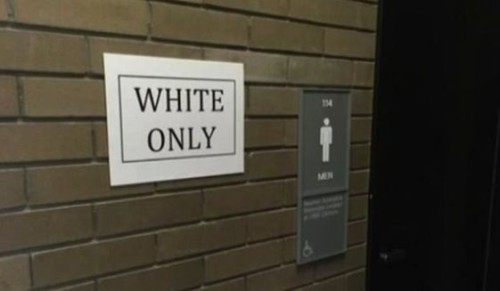Art Student Hangs ‘Black Only’ And ‘White Only’ Signs Around University Campus
Share
Explore Our Galleries
Breaking News!
Today's news and culture by Black and other reporters in the Black and mainstream media.
Ways to Support ABHM?
By Priscilla Frank, Arts Writer, The Huffington Post
On Wednesday, Sept. 16, students of the University of Buffalo were shocked to find “White Only” and “Black Only” signs hung near campus bathrooms. Students were sickened and traumatized by the apparent act of racism; by 1 p.m., the police had received 11 phone calls regarding the signage.
It was later revealed, however, that the signs reminiscent of the Jim Crow era were put on display by graduate fine arts student Ashley Powell, who is black, as part of an art project.

Before Powell admitted to hanging the signs at a Black Student Union (BSU) meeting on Wednesday night, students and faculty were left wondering about the source of the racist designations. “We didn’t know it was an art project, it could’ve been an act of terrorism,” a student explained to The Spectrum, the independent campus newspaper.
When Powell revealed that she was behind the act, a project for her “Installation: Urban Spaces” class, which requires students to install art in a public space, many students stormed out of the BSU assembly, some in tears. “It brought up feelings of a past that our generation has never seen, which I think is why it was so shocking for us to see,” Micah Oliver, president of the BSU, told ABC.
“As an artist, I respect you as an artist,” said student Jefry Taveras in the BSU meeting. “But you should know racism isn’t art, it’s a reality and traumatizing.”
In a statement to The Spectrum, Powell explained the reasoning behind her installation, which addresses issues of non-white suffering and white privilege. “I apologize for the extreme trauma, fear, and actual hurt and pain these signs brought about,” she wrote. “I apologize if you were hurt, but I do not apologize for what I did.”
She went on to expand upon the motivations behind the project, which was intended to spark outrage and discomfort in viewers.
“My art practice is not an act of self-policing meant to hide my rage. Instead, it uses pain, narrative, and trauma as a medium of expression and as grounds for arguing a need for change in the first place. I understand that I forced people to feel pain that they otherwise would not have had to deal with in this magnitude. But I ask, should non-white people not express or confront their trauma? Should we be content with not having to confront that pain? We know it exists, and it often causes many of us immediate discomfort. Should we not be in a state of crushing discomfort?
These signs made you feel discomfort. They are tangible objects that forced you to revisit your past, to confront your present, and to recognize here and now the underlying social structures that are directly responsible for your pain and suffering. This project makes forceful what has been easy for you to ignore.”
Read Powell’s statement in full here.
Read the full article here.
Read more Breaking News here.









Comments Are Welcome
Note: We moderate submissions in order to create a space for meaningful dialogue, a space where museum visitors – adults and youth –– can exchange informed, thoughtful, and relevant comments that add value to our exhibits.
Racial slurs, personal attacks, obscenity, profanity, and SHOUTING do not meet the above standard. Such comments are posted in the exhibit Hateful Speech. Commercial promotions, impersonations, and incoherent comments likewise fail to meet our goals, so will not be posted. Submissions longer than 120 words will be shortened.
See our full Comments Policy here.